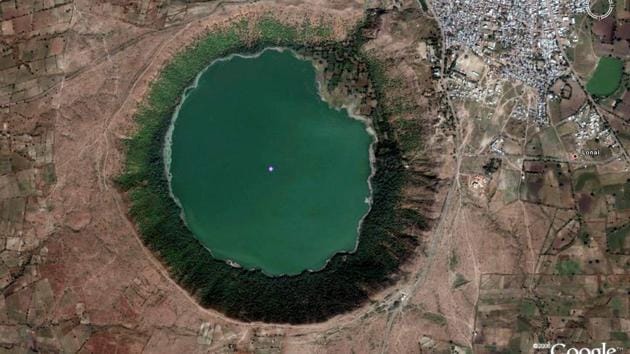Mineral contents of Buldhana’s Lonar lake similar to moon rocks: IIT-Bombay study
A meteorite crash occurs when a meteoroid rock – it is formed when asteroids break or collide – survives its travel through the Earth’s atmosphere and lands on the Earth’s surface.
Mineral contents of samples from the Lonar crater-cum-lake in Buldhana district, Maharashtra, which was formed after a meteorite crash around 50,000 years ago, are similar to the moon rocks obtained from the first and third manned moon missions, according to a study led by the Indian Institute of Technology (IIT), Bombay.

A meteorite crash occurs when a meteoroid rock – it is formed when asteroids break or collide – survives its travel through the Earth’s atmosphere and lands on the Earth’s surface. Meteorites are classified as stony (composed of oxygen, iron, silicon and magnesium) or iron (predominantly made of iron and nickel) or a combination of stony-iron. The Lonar crater in the basaltic Deccan traps is the Earth’s largest and only hyper-velocity impact terrestrial crater caused by a meteorite crash. The Lonar crater and Meteor Crater in Arizona are the only two known natural craters formed entirely in basalt – a dark fine-grained volcanic rock – and comparable to the basaltic crust on Mars.
For long, the Lonar crater was thought to have been formed owing to a volcanic eruption. It was only in the latter half of the 20th century that studies found significant changes to the minerals in the native soil as a result of its prolonged interaction with extra-terrestrial matter, confirming the crater-cum-lake was created by a meteorite crash. Previous studies have concentrated on the magnetic, gravitational, and biological parameters associated with the meteor impact.
Researchers in the current study investigated the characteristics of the soil and water collected from the Lonar crater. “We wanted to investigate and assess the geomechanical fingerprints of the impact of the meteorite crash because there always is mineral alteration of a geomaterial when it interacts with water at elevated temperatures .... a phenomenon commonly defined as hydrothermal interaction, which might result in zeolitization,” said Prof DN Singh, principal investigator and institute chair professor, geotechnical engineering division, department of civil engineering, IIT-Bombay. “Investigating the remains from the meteorite crash can also help reconstruction of human civilisation on planet Earth.”
The team including researchers from Dr Babasaheb Bhimrao Ambedkar Government Polytechnic, Karad, and Dr Manager Singh, director general, National Research Laboratory for Conservation of Cultural Property, Lucknow, and formerly chief conservation officer, Archaeological Survey of India (ASI), Aurangabad, extracted three soil samples from three different locations within the formation of the Lonar crater bowl.
In addition to studying the samples for their physical, chemical, structural and electrical properties, soil particles were analysed for their mineral content, surface structure, and features of surface pores. These researchers found higher iron content – 10.4% to 11.9% – in all three soil samples compared to native soils. Normal soil has high concentrations of organic compounds (they contain carbon along with other elements essential for living organisms) and less amounts of iron and aluminium. Unlike lakes in the area, water from the Lonar lake is highly saline owing to the presence of sodium, magnesium and calcium ionic species. Similarly, the aluminium content in all three samples was as high as 20.15%, which is identical to that found in the moon rock brought by the Apollo 11 mission. Apollo 11 was the first manned mission to land on the moon on July 20, 1969 when astronauts Neil Armstrong and Buzz Aldrin took their first steps on the Earth’s natural satellite, and returned with first samples of moon rocks. Findings showed that the morphology of one sample was the outcome of high energy impact between the original Lonar soil and the meteor. High titanium content – more than 2% – present in the form of glass and in minerals, pigeonite and diopside, was found to be similar to moon rock samples brought back the Apollo 14 mission – the eighth manned mission and third to land on the moon. Researchers said the presence of anorthite, albite and zeolite minerals, which are also found in moon rocks, indicate their travel from extra-terrestrial space to the Lonar crater-cum-lake. Researchers said soil studies mark the abundant presence of nickel, platinum and iridium, which is not usually found in the earth’s interior. “Soil mineralogical studies give an overall picture of how the ecosystem and environment was recreated after the meteorite crash which is different from localised ecological disturbances,” said Dr. Manager Singh, co-author.
Stay updated with all the Breaking News and Latest News from Mumbai. Click here for comprehensive coverage of top Cities including Bengaluru, Delhi, Hyderabad, and more across India along with Stay informed on the latest happenings in World News.
Stay updated with all the Breaking News and Latest News from Mumbai. Click here for comprehensive coverage of top Cities including Bengaluru, Delhi, Hyderabad, and more across India along with Stay informed on the latest happenings in World News.





